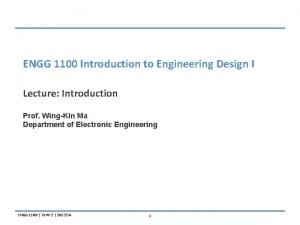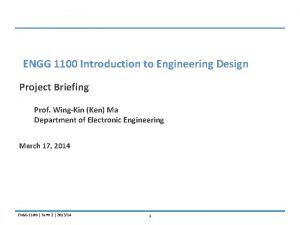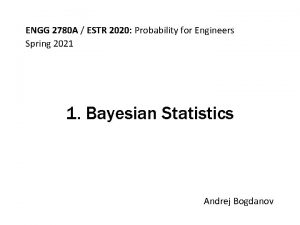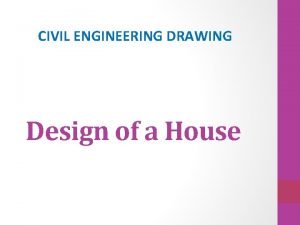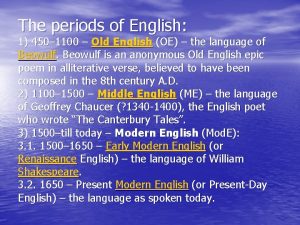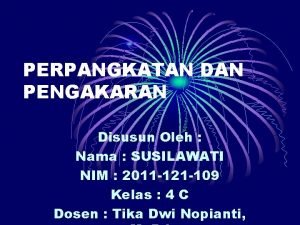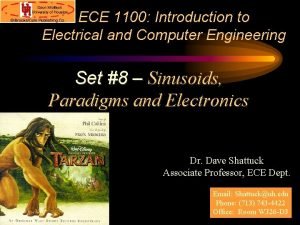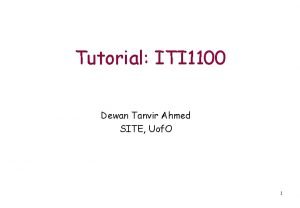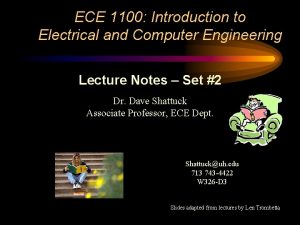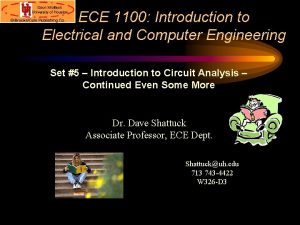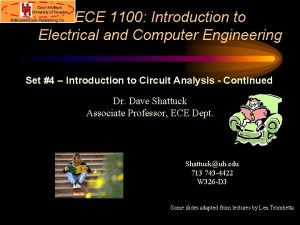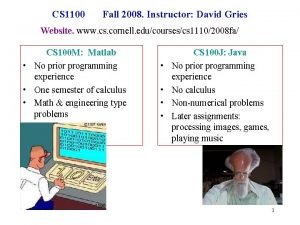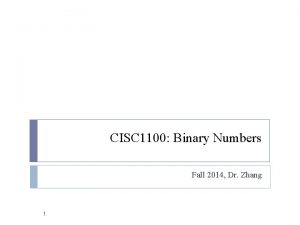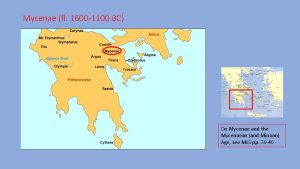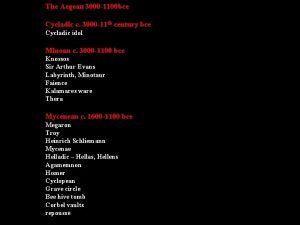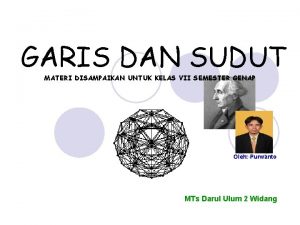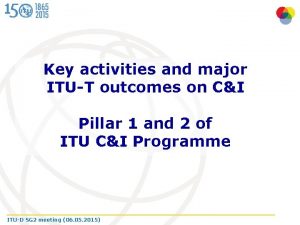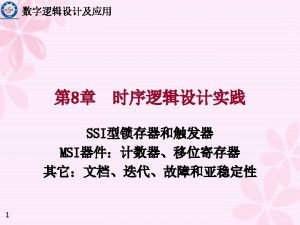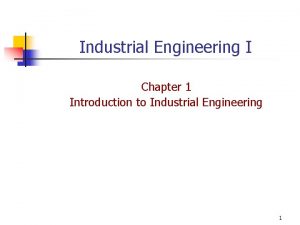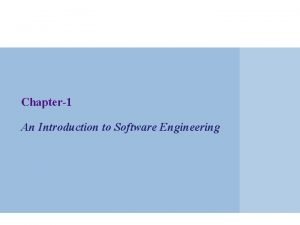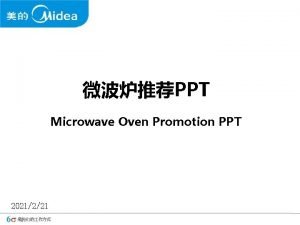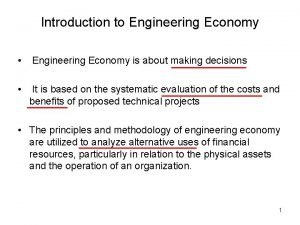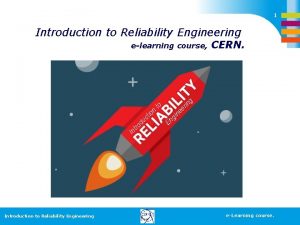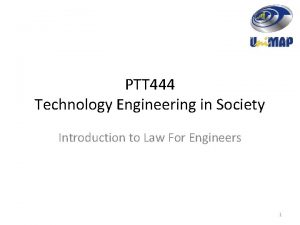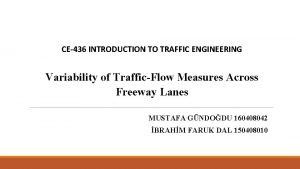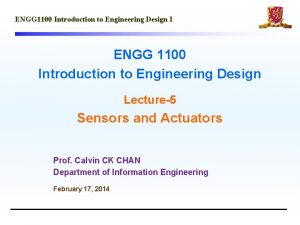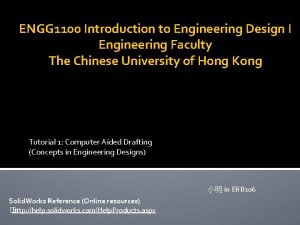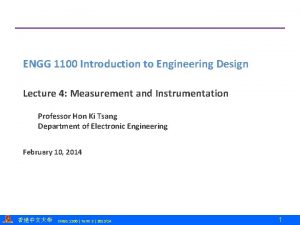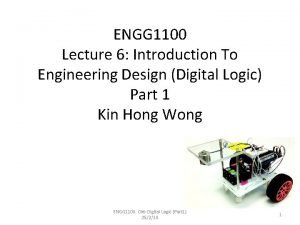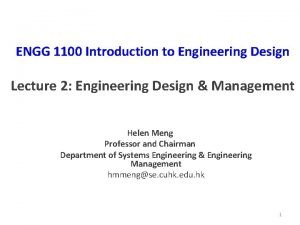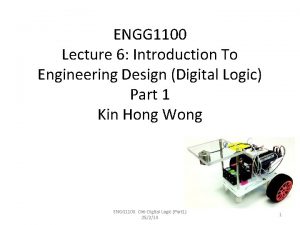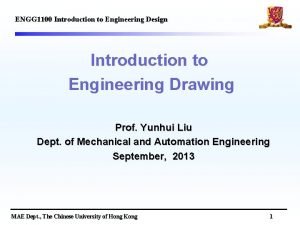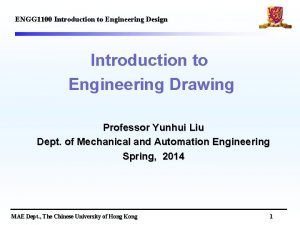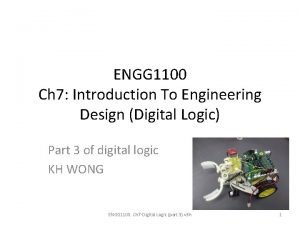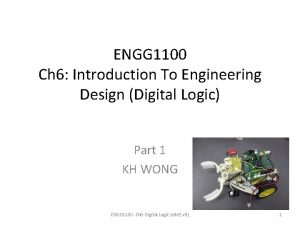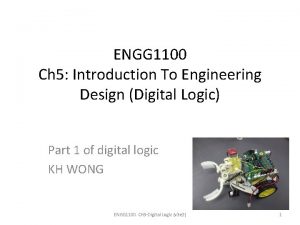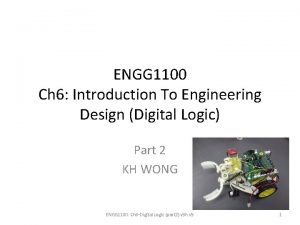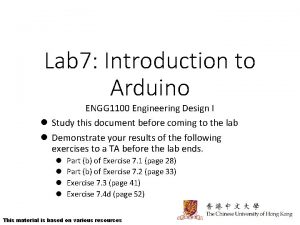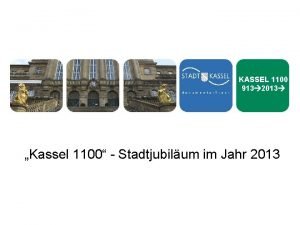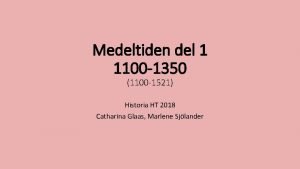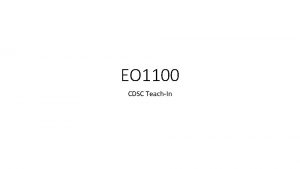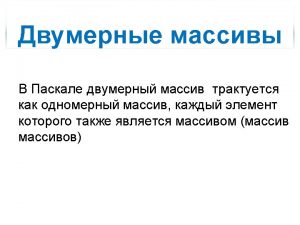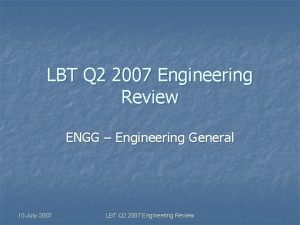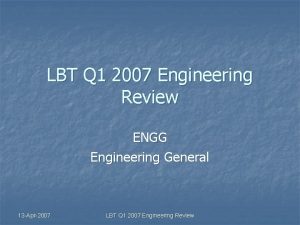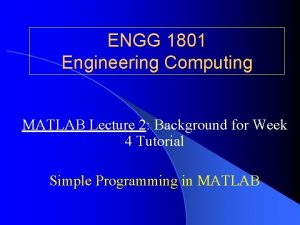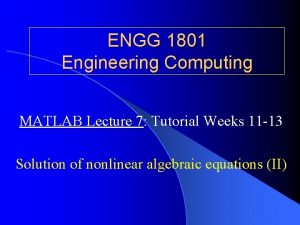ENGG 1100 Introduction to Engineering Design Lecture 3



























































- Slides: 59

ENGG 1100 Introduction to Engineering Design Lecture 3: Basic Electronics & Lab Safety Prof. Wing-Kin (Ken) Ma Department of Electronic Engineering Acknowledgement: those who helped develop this slide over the years, particularly, Mr. Hoi-To Wai (now with UC Davis), and Dr. Matthew Tang (now with Queen Mary University of London); also Prof. Alex Leung at electronic engineering, CUHK. Some of the pictures were obtained from the internet. January 27, 2014 ENGG 1100 | Term 2 | 2013/14 1

Objectives • To understand basic circuits concepts, namely, voltage, current and resistors. • To introduce to you how voltage and current are measured. • To talk about lab safety. Note that • these concepts are relevant to Lab 2 (today’s lab); • you may have learnt these basic concepts in secondary school physics courses, but you need to better understand them in this course (or perhaps you might have never truly understood them). ENGG 1100 | Term 2 | 2013/14 2

References • An optional, very friendly, reference: Forest M. Mims III, Getting Started in Electronics ENGG 1100 | Term 2 | 2013/14 3

BASIC ELECTRONICS: A ROUGH INTRODUCTION ENGG 1100 | Term 2 | 2013/14 4

Some Electronic Components • Resistors – providing resistance (actually every matter on earth is a resistor) Source: http: //en. wikipedia. org/wiki/Resistor • Capacitors – storehouse for charges Source: http: //en. wikipedia. org/wiki/Capacitor ENGG 1100 | Term 2 | 2013/14 5 Source: http: //www. electronicrepairguide. com/smd-resistor-code. html

Electronic Component Symbols • Electronic components are represented using standardized symbols: ENGG 1100 | Term 2 | 2013/14 6

Circuits & Schematics • What do the real circuits & schematics look like… • A circuit is a connection of different electronic components. ENGG 1100 | Term 2 | 2013/14 7

These are also circuits, in a much more complex way Pentium 4 CPU Quad-core CPU ENGG 1100 | Term 2 | 2013/14 8

Transistors and integrated circuits (ICs) William Schockley (Inventor of transistor) Point-contact transistor invented in 1947 at Bell lab. IC = ENGG 1100 | Term 2 | 2013/14 9 Transistors Scaling down the size of the components and put all components in a small area

What does a transistor do? • Transistors play an indispensable role in electronics and other areas. • Simply speaking, a transistor works like an electronic switch (It can also perform signal amplification, e. g. in Hi. Fi). press/release transistor switch or ENGG 1100 | Term 2 | 2013/14 10

Okay, so what’s the big deal? • Transistors, together with other components, like resistors, capacitors, inductors, diodes, …, enable us to build many different circuits. • Example: Use of transistors enables digital logics. A B AND A Out OR B Out A A B B • With digital logistics, we can compute (without doing it ourselves)… • And with the ability to compute, we have modern computers (and that includes your i. Phone). ENGG 1100 | Term 2 | 2013/14 11

So we build things bigger and bigger to compute, and yet size smaller and smaller Electronic Delay Storage Automatic Calculator in 1949 (addition, subtraction, multiplication, square, prime numbers, etc. ) ENGG 1100 | Term 2 | 2013/14 12 (You do know what these gadgets are, don’t you)

• Electronics provides “primal elements” behind almost all modern technology. • Roughly speaking, it gives us the key building blocks for fields like wireless communications, optical communications, information technology, biomedical engineering, and many, many more. Who is he? • Without electronic and associated engineering technologies, we may not have mobile, internet, FB or Whatsapps (which some of you might be using in my lecture). Oh, wash you own clothes (by hand), too! ENGG 1100 | Term 2 | 2013/14 13

RESISTORS, VOLTAGE AND CURRENT ENGG 1100 | Term 2 | 2013/14 14

Resistor Circuits • Consider the following simple resistor circuit: Power supply Resistor • The famous Ohm’s Law: ENGG 1100 | Term 2 | 2013/14 15

A Circuit and its water analogy Water level – Voltage (V) Slit/opening – Resistance (R) Water – Charge (Q) Stream – Current (I) The famous Ohm’s Law: • Note: do not take these analogies too far. ENGG 1100 | Term 2 | 2013/14 16

Another (awkward) analogy I might use • Note: again it could be misleading! ENGG 1100 | Term 2 | 2013/14 17

Voltage, Current and Resistance • Current • describes the flow of positive charges through the circuit • measured in units of Amperes (A) • is, by theory, defined as where I is the current, and Q is the charge, in Coulombs (C). ENGG 1100 | Term 2 | 2013/14 18

Voltage, Current and Resistance • Voltage • • describes the potential for current to flow in the circuit measured in units of Volts (V) Voltage is related to energy, measured in Joules. The energy required to move a particle with Q Coulombs from a place of 0 V to a place with V V is where E represents the energy (in Joules). ENGG 1100 | Term 2 | 2013/14 19

Voltage, Current and Resistance • Resistor • is a device that resists the flow of current • allows current to flow, but the amount depends on the value of the resistor and the voltage applied • The value of the resistor, or simply resistance, is measured in units of Ohms (Ω) • By Ohm’s law, we have where R represents the resistance (in Ω). ENGG 1100 | Term 2 | 2013/14 20

Voltage, Current and Resistance • Power • is the rate of energy dissipation with respect to time • is in units of Joules per second, or Watts (W) • is given by where P represents the power (in W). • By Ohm’s law, we have ENGG 1100 | Term 2 | 2013/14 21

Basic circuit analysis • The Ohm’s law • Don’t be afraid of the equations ENGG 1100 | Term 2 | 2013/14 22

Resistors in series • We have • Equivalent resistance: ENGG 1100 | Term 2 | 2013/14 23

Analogy for resistors in series ENGG 1100 | Term 2 | 2013/14 24

Resistors in parallel • Voltage on each resistor = the same: • Current coming in = current coming out: • Equivalent resistance ENGG 1100 | Term 2 | 2013/14 25

Analogy for resistors in parallel ENGG 1100 | Term 2 | 2013/14 26

Example ENGG 1100 | Term 2 | 2013/14 27

Kirchhoff’s circuit laws • Two important theorems for circuit analysis Kirchhoff’s current law (KCL) Kirchhoff’s voltage law (KVL) Net current entering a node = 0 Net voltage in a loop = 0 (CAUTION: mind the direction/sign of current and voltage) ENGG 1100 | Term 2 | 2013/14 28

Application -- voltage divider • We probably don’t need something as complex as the last example • Consider the resistors in series again: (let N=2) • The supplied voltage V is divided into two parts • This principle is called the Voltage Divider ENGG 1100 | Term 2 | 2013/14 29

Application – current divider • Consider the resistors in parallel : (let N=2) • The current I is divided into two parts • More current flows in the branch with less resistance • This principle is called the Current Divider ENGG 1100 | Term 2 | 2013/14 30

ADDITIONAL NOTE ENGG 1100 | Term 2 | 2013/14 31

Units and dimensions • International System of Units (SI) takes the convenience of the base 10 (decimal) system. • A prefix may be added to a unit to produce a multiple (powers of ten) of the original unit. Name deca- hecto- kilo- mega- giga- tera- peta- Symbol da h k M G T P Factor 101 102 103 106 109 1012 1015 Name deci- centi- milli- micro- nano- pico- femto- Symbol d c m μ n p f Factor 10 -1 10 -2 10 -3 10 -6 10 -9 10 -12 10 -15 Example 1: 10 m. A = 10 x 10 -3 A = 0. 01 A Example 2: 0. 3 MΩ = 0. 3 x 106 Ω = 300 000 Ω ENGG 1100 | Term 2 | 2012/13 32

Electronic Color Code Resistor a b c Resistance = [ ( a ‘s value ) × 10 + ( b ‘s value ) ] Color Value Multiplier Black 0 × 1 Brown 1 × 10 Red 2 × 100 Orange 3 × 1 000 Yellow 4 × 10 000 Green 5 × 100 000 Blue 6 × 1 000 Purple 7 × 10 000 Grey 8 × 100 000 White 9 × 1 000 000 ENGG 1100 | Term 2 | 2012/13 × ( c ‘s multiplier ) Example: Resistance = Blue Red Orange = 6 2 × 1000 = 62000Ω 33 33

Basic rules for connecting a circuit • RULE #1 – a circuit must contain a closed loop • Without a closed loop, a circuit is said to be open • An open circuit cannot function as there is no returning path for current ENGG 1100 | Term 2 | 2013/14 34

Basic rules for connecting a circuit • RULE #2 – a circuit (usually) contains a power source Showing different ways of representing a power source • The power source provides power to make the circuit function ENGG 1100 | Term 2 | 2013/14 35

Basic rules for connecting a circuit • RULE #3 – electronic components are connected to a node Three seemingly different schematics. They are actually describing the same circuit. • The lines in a schematic serve only one purpose – to make connections between components ENGG 1100 | Term 2 | 2013/14 36

MEASUREMENT OF VOLTAGE, CURRENT AND RESISTANCE ENGG 1100 | Term 2 | 2013/14 37

Measurement of Voltage and Current • Multimeters are all-in-one devices that measure different electrical quantities • Current (I), voltage (V), resistance (R) in one device ENGG 1100 | Term 2 | 2013/14 38

Application -- ammeter • Ammeters are devices that measure the Current (I) Source: http: //www. tpub. com/neets/book 16/68. htm • Galvanometer (found in the analog ammeters) • The needle movement is proportional to the current I • Typical range: from 0 A to 1 m. A ENGG 1100 | Term 2 | 2013/14 39

Application -- ammeter • Using an ammeter to measure current at a point: • “Break” the circuit and insert the ammeter Equivalent model of an ammeter -- the internal resistance of the galvanometer -- can be adjusted for range selection (current divider) ENGG 1100 | Term 2 | 2013/14 40

Application -- ammeter The current reading is 0. 51 m. A Circuit connected in series ENGG 1100 | Term 2 | 2013/14 41

Application -- voltmeter • Voltmeters are devices that measure the Voltage (V): • Voltage is defined relatively must be measured “between two points” Equivalent model of a voltmeter • Very large, typical range = 200 k Ω - 1 M Ω • only a small current will flow through the voltmeter (current divider) • can be adjusted to select the range ENGG 1100 | Term 2 | 2013/14 42

Application -- voltmeter The voltage reading is 5. 03 V Circuit connected in parallel ENGG 1100 | Term 2 | 2013/14 43

Application -- ohmmeter • Ohmmeters are devices that measure the Resistance (R): • Resistance is also defined between two points • Just like the voltmeter Equivalent model of an ohmmeter • An ohmmeter = an ammeter + battery • From Ohm’s Law, ENGG 1100 | Term 2 | 2013/14 44

TAKE-HOME EXECRISES ENGG 1100 | Term 2 | 2013/14 45

Question 1 • Express the voltage Va as a function of V, R 1 and R 2 ENGG 1100 | Term 2 | 2013/14 46

Question 2 • What is the current measured by the ammeter? ENGG 1100 | Term 2 | 2013/14 47

Question 3 • What is the resistance measured by the ohmmeter? ENGG 1100 | Term 2 | 2013/14 48

LAB SAFETY ENGG 1100 | Term 2 | 2013/14 49

You (probably) don’t want to do this in the lab… http: //www. youtube. com/watch? v=JCPXckf. T-6 g ENGG 1100 | Term 2 | 2013/14 50

Appropriate dressing • Hair: long hair must be tied or restrained to prevent accidental contact with lab equipment • Loose or hanging clothing must not be worn (ties, scarves) • Footwear: due to the risk of electric shock, bare feet are never allowed in any lab area at any time • Soldering: Anyone doing any soldering work in the laboratory areas must wear a shirt, long pants or long skirt, socks, and covered shoes • Prevent the possibility of severe burns resulting from the splashing or dripping of hot liquefied solder ENGG 1100 | Term 2 | 2013/14 51

Proper attire • Lab benches must be kept in neat order and returned to the condition found when you are finished • We are sharing the labs with other courses and students. Don’t be selfish • No food and drink should be consumed at the lab benches • Do not use a pen as a pointer when reading meters or oscilloscope • No horseplay! • Beware of slips, trips and falls ENGG 1100 | Term 2 | 2013/14 52

Understand the floor plan of your lab Fire Extinguisher bench bench bench First Aid Box ENGG 1100 | Term 2 | 2013/14 53 Circuit breaker panel

Know your equipment • Always study the lab manual before coming to the Lab, ask your TAs if you have questions • Do not drop any equipment • Make circuit connections with all the power sources off • Activate adjustable power sources at a low level when powering an untested circuit • Make sure that all components and instrumentation have the proper ratings and are used on the appropriate range ENGG 1100 | Term 2 | 2013/14 54

Minor injury • Turn off any equipment/machinery involved • Perform appropriate first aid • Inform lab instructor/personnel, seek medical assistance as appropriate • Call the University Health Center (UHS) on 3943 6423 on weekdays ENGG 1100 | Term 2 | 2013/14 55

Emergency procedure: electrical shock • Do no touch someone who is being electrocuted. • If it is possible to do so safely, turn off the power supply. • Otherwise, use a piece of lumber or other non-conducting material to separate the person from the energized conductor. • Check the afflicted person for pulse and respiration. • Only qualified individuals should attempt CPR. • In cases of electrocution, medical assistance should be summoned immediately. ENGG 1100 | Term 2 | 2013/14 56

Emergency procedure: fire • Turn on a fire alarm if you have any doubt that you may fail to put out the fire. Turn on a fire alarm for any serious emergency such as toxic gas release or explosion. • Use a laboratory fire extinguisher on incipient fires. When possible, use CO 2 units instead of dry chemical units where instruments are involved to minimize damage. • Take an extinguisher with you to check out an area where there may be a fire. • After using a fire extinguisher, turn it in for replacement. • If an individual's clothing is on fire, roll them on the floor and wrap them in a coat or blanket if possible. • If you hear a fire alarm in your building, leave the building immediately. ENGG 1100 | Term 2 | 2013/14 57

Emergency : Medical Assistance • For urgent medical attention, go straight to the Accident & Emergency Department of any major hospitals • The nearest Accident & Emergency Department to the Chinese University is the Prince of Wales Hospital in Shatin, NT • Telephone: 2632 3250 • For ambulance service, dial 2735 3355 (Fire Services Department) or 999. Identify yourself and give your exact location • It is advisable to notify the Security Office at 3943 7999 so that the ambulance may be directed to the exact location more readily ENGG 1100 | Term 2 | 2013/14 58

References • University Safety & Environment Office (USEO) http: //www. cuhk. edu. hk/useo • University Health Service http: //www. cuhk. edu. hk/uhs • Laboratory safety guidelines (Arizona State University) • ECE Department Undergraduate Laboratory: Safety and Operations Manual (Clarkson University) ENGG 1100 | Term 2 | 2013/14 59
 Engg 1100
Engg 1100 Engg 1100
Engg 1100 Engg 2780
Engg 2780 House civil engineering drawing
House civil engineering drawing 01:640:244 lecture notes - lecture 15: plat, idah, farad
01:640:244 lecture notes - lecture 15: plat, idah, farad Scanpro 1100
Scanpro 1100 Old english 450 to 1100
Old english 450 to 1100 Kaltschmidt gernrode
Kaltschmidt gernrode Akar kuadrat dari 3969
Akar kuadrat dari 3969 Ece 1100
Ece 1100 Dewan tanvir ahmed
Dewan tanvir ahmed Dewan tanvir ahmed
Dewan tanvir ahmed Language
Language Ece 1100
Ece 1100 Ece 1100
Ece 1100 Ece 1100
Ece 1100 Cs 1100 cornell
Cs 1100 cornell 1100 binary
1100 binary Lexile range
Lexile range 1600-1100
1600-1100 District 1100
District 1100 Iti1100
Iti1100 3000 - 1100
3000 - 1100 Gambar sudut 90°
Gambar sudut 90° 1100-675
1100-675 Lightel ci-1100
Lightel ci-1100 Itu-t p.1110
Itu-t p.1110 Olympus deltis vc-1100
Olympus deltis vc-1100 0011 0111
0011 0111 Money-time relationship and equivalence
Money-time relationship and equivalence Requirement analysis in software engineering notes
Requirement analysis in software engineering notes Foundation engineering lecture notes
Foundation engineering lecture notes Engineering ethics lecture notes
Engineering ethics lecture notes Introduction to biochemistry lecture notes
Introduction to biochemistry lecture notes Introduction to psychology lecture
Introduction to psychology lecture Introduction to algorithms lecture notes
Introduction to algorithms lecture notes Anchorage length eurocode
Anchorage length eurocode Urban design lecture
Urban design lecture Principles of interior design ppt
Principles of interior design ppt Lecture hall background
Lecture hall background Game design lecture
Game design lecture Computer-aided drug design lecture notes
Computer-aided drug design lecture notes Cmos vlsi design lecture notes
Cmos vlsi design lecture notes Computer based system engineering
Computer based system engineering Forward engineering in software engineering
Forward engineering in software engineering Engineering elegant systems: theory of systems engineering
Engineering elegant systems: theory of systems engineering Engineering elegant systems: theory of systems engineering
Engineering elegant systems: theory of systems engineering Reverse engineering vs forward engineering
Reverse engineering vs forward engineering Orthographic projection to isometric projection
Orthographic projection to isometric projection Introduction to civil engineering
Introduction to civil engineering Industrial engineering approach
Industrial engineering approach Changing nature of software engineering
Changing nature of software engineering Microwave photonics ppt
Microwave photonics ppt Introduction to web engineering
Introduction to web engineering Introduction to engineering economy
Introduction to engineering economy Scope of engineering economics
Scope of engineering economics Introduction to reliability engineering
Introduction to reliability engineering Ptt 444
Ptt 444 Introduction to engineering surveying
Introduction to engineering surveying Introduction to traffic engineering
Introduction to traffic engineering
